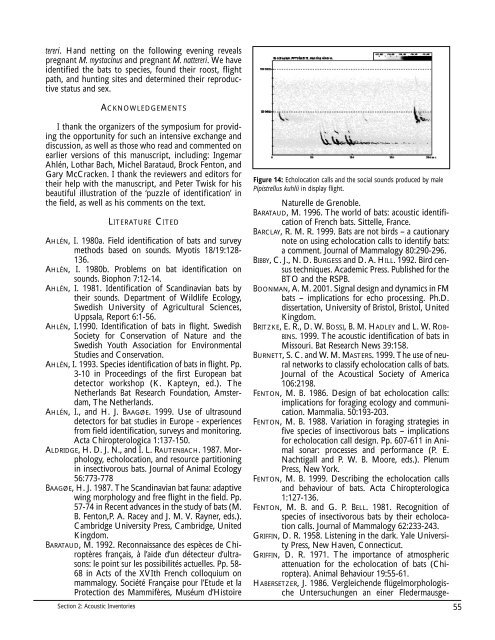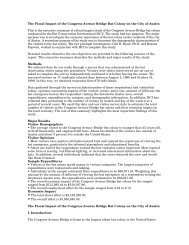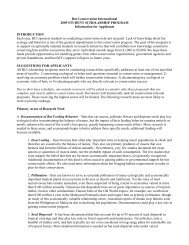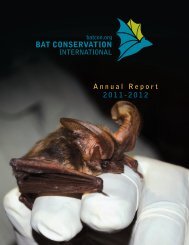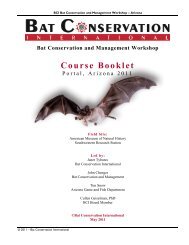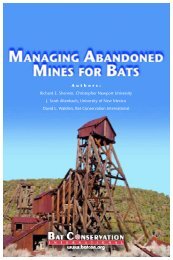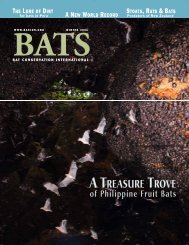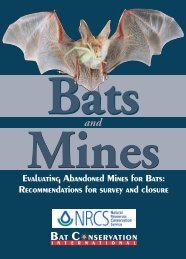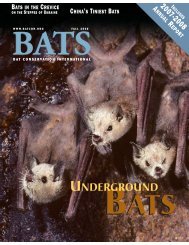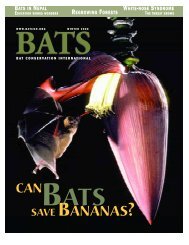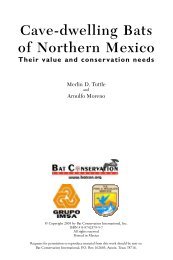Bat Echolocation Researc h - Bat Conservation International
Bat Echolocation Researc h - Bat Conservation International
Bat Echolocation Researc h - Bat Conservation International
Create successful ePaper yourself
Turn your PDF publications into a flip-book with our unique Google optimized e-Paper software.
tereri. Hand netting on the following evening reveals<br />
pregnant M. mystacinus and pregnant M. nattereri. We have<br />
identified the bats to species, found their roost, flight<br />
path, and hunting sites and determined their reproductive<br />
status and sex.<br />
ACKNOWLEDGEMENTS<br />
I thank the organizers of the symposium for providing<br />
the opportunity for such an intensive exchange and<br />
discussion, as well as those who read and commented on<br />
earlier versions of this manuscript, including: Ingemar<br />
Ahlén, Lothar Bach, Michel Barataud, Brock Fenton, and<br />
Gary McCracken. I thank the reviewers and editors for<br />
their help with the manuscript, and Peter Twisk for his<br />
beautiful illustration of the ‘puzzle of identification’ in<br />
the field, as well as his comments on the text.<br />
Section 2: Acoustic Inventories<br />
LITERATURE CITED<br />
AHLÉN, I. 1980a. Field identification of bats and survey<br />
methods based on sounds. Myotis 18/19:128-<br />
136.<br />
AHLÉN, I. 1980b. Problems on bat identification on<br />
sounds. Biophon 7:12-14.<br />
AHLÉN, I. 1981. Identification of Scandinavian bats by<br />
their sounds. Department of Wildlife Ecology,<br />
Swedish University of Agricultural Sciences,<br />
Uppsala, Report 6:1-56.<br />
AHLÉN, I.1990. Identification of bats in flight. Swedish<br />
Society for <strong>Conservation</strong> of Nature and the<br />
Swedish Youth Association for Environmental<br />
Studies and <strong>Conservation</strong>.<br />
AHLÉN, I. 1993. Species identification of bats in flight. Pp.<br />
3-10 in Proceedings of the first European bat<br />
detector workshop (K. Kapteyn, ed.). The<br />
Netherlands <strong>Bat</strong> <strong>Researc</strong>h Foundation, Amsterdam,<br />
The Netherlands.<br />
AHLÉN, I., and H. J. BAAGØE. 1999. Use of ultrasound<br />
detectors for bat studies in Europe - experiences<br />
from field identification, surveys and monitoring.<br />
Acta Chiropterologica 1:137-150.<br />
ALDRIDGE, H. D. J. N., and I. L. RAUTENBACH. 1987. Morphology,<br />
echolocation, and resource partitioning<br />
in insectivorous bats. Journal of Animal Ecology<br />
56:773-778<br />
BAAGØE, H. J. 1987. The Scandinavian bat fauna: adaptive<br />
wing morphology and free flight in the field. Pp.<br />
57-74 in Recent advances in the study of bats (M.<br />
B. Fenton,P. A. Racey and J. M. V. Rayner, eds.).<br />
Cambridge University Press, Cambridge, United<br />
Kingdom.<br />
BARATAUD, M. 1992. Reconnaissance des espèces de Chiroptères<br />
français, à l’aide d’un détecteur d’ultrasons:<br />
le point sur les possibilités actuelles. Pp. 58-<br />
68 in Acts of the XVIth French colloquium on<br />
mammalogy. Société Française pour l’Etude et la<br />
Protection des Mammifères, Muséum d’Histoire<br />
Figure 14: <strong>Echolocation</strong> calls and the social sounds produced by male<br />
Pipistrellus kuhlii in display flight.<br />
Naturelle de Grenoble.<br />
BARATAUD, M. 1996. The world of bats: acoustic identification<br />
of French bats. Sittelle, France.<br />
BARCLAY, R. M. R. 1999. <strong>Bat</strong>s are not birds – a cautionary<br />
note on using echolocation calls to identify bats:<br />
a comment. Journal of Mammalogy 80:290-296.<br />
BIBBY, C. J., N. D. BURGESS and D. A. HILL. 1992. Bird census<br />
techniques. Academic Press. Published for the<br />
BTO and the RSPB.<br />
BOONMAN, A. M. 2001. Signal design and dynamics in FM<br />
bats – implications for echo processing. Ph.D.<br />
dissertation, University of Bristol, Bristol, United<br />
Kingdom.<br />
BRITZKE, E. R., D. W. BOSSI, B. M. HADLEY and L. W. ROB-<br />
BINS. 1999. The acoustic identification of bats in<br />
Missouri. <strong>Bat</strong> <strong>Researc</strong>h News 39:158.<br />
BURNETT, S. C. and W. M. MASTERS. 1999. The use of neural<br />
networks to classify echolocation calls of bats.<br />
Journal of the Acoustical Society of America<br />
106:2198.<br />
FENTON, M. B. 1986. Design of bat echolocation calls:<br />
implications for foraging ecology and communication.<br />
Mammalia. 50:193-203.<br />
FENTON, M. B. 1988. Variation in foraging strategies in<br />
five species of insectivorous bats – implications<br />
for echolocation call design. Pp. 607-611 in Animal<br />
sonar: processes and performance (P. E.<br />
Nachtigall and P. W. B. Moore, eds.). Plenum<br />
Press, New York.<br />
FENTON, M. B. 1999. Describing the echolocation calls<br />
and behaviour of bats. Acta Chiropterologica<br />
1:127-136.<br />
FENTON, M. B. and G. P. BELL. 1981. Recognition of<br />
species of insectivorous bats by their echolocation<br />
calls. Journal of Mammalogy 62:233-243.<br />
GRIFFIN, D. R. 1958. Listening in the dark. Yale University<br />
Press, New Haven, Connecticut.<br />
GRIFFIN, D. R. 1971. The importance of atmospheric<br />
attenuation for the echolocation of bats (Chiroptera).<br />
Animal Behaviour 19:55-61.<br />
HABERSETZER, J. 1986. Vergleichende flügelmorphologische<br />
Untersuchungen an einer Fledermausge-<br />
55


